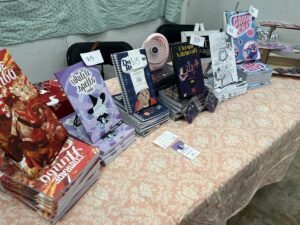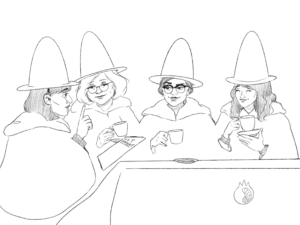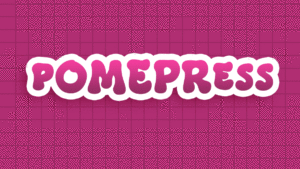Way back in 2013, when Orange is the New Black kicked off on Netflix, showrunner Jenji Kohan explained the program’s racial dynamics to Terry Gross. “In a lot of ways Piper was my Trojan Horse,” Kohan remarked. “You’re not going to go into a network and sell a show on really fascinating tales of black women, and Latina women, and old women and criminals.”
Three seasons of OITNB later, I’m still lukewarm about this approach. In some respects, Kohan is right to perceive herself as a double-agent; women lead only 25% of all non-broadcast TV shows–It’s not exactly a medium friendly to non-male identities. After spending hours with Piper, Poussey, and Taystee, however, I agree with The Feminist Wire’s assertion that OITNB “provides a relative voice for trans and queer issues” while “Black and Latin[x] experiences are diluted through myopic stereotypes and racist tropes.” Because Piper is at the center of the OITNB universe, a white frosting coats the entire narrative. OITNB isn’t about the realities of the prison-industrial complex; it’s about how white culture imagines incarceration.
On that note, if OITNB is a part of your winter binge-watching plans, you might also appreciate some further reading on the matter. If you’re looking to add 100XP to your social justice know-how, check out these books to curl up and get angry with–the rage will keep you warm.
1. Inside This Place, Not of It: Narratives From Women’s Prisons
Compiled and Edited by Robin Levi and Ayelet Waldman
“Inside” is a quilt of oral histories chronicling experiences inside women’s prisons. Michelle Alexander, author of The New Jim Crow, writes in the introduction that this storytelling shows “a path toward a more forgiving, compassionate, and caring society” with the hope it will “improve the lives of our most vulnerable rather than sweeping them behind bars.” One of these 13 accounts comes from Charlie Morningstar, a Native American trans man who is currently incarcerated in a women’s facility. Morningstar’s personal account demonstrates the isolation, violence, and poverty that often paves a pathway to prison. It’s critical for feminists and prison abolitionists to consider how the penal system systematically preys upon transgender citizens, especially those of color; these accounts are a good place to begin.
2. The Meaning of Freedom and Other Difficult Dialogues
by Angela Davis
Davis is an asskicking political activist and educator whose name is almost synonymous with social justice; this collection of speeches and essays shows why. Chapter two, simply titled “The Prison-Industrial Complex,” comes from Davis’ address at Colorado College in 1997 and deftly breaks down mass incarceration’s tangled web of money and racism. “Many will be lured into the drug economy or the economy in sexual services, two of the major alternatives available to people barred from the mainstream economy,” she writes. “This will send them straight to jail or prison…their presence there will justify the further expansion of the prison-industrial complex.” Freedom is essentially a power-packed vitamin full of the ideological nutrition OITNB glosses over or leaves out.
3. Bitch Planet
by Kelly Sue Deconnick and Valentine De Landro
This comics series is the greatest thing to happen to paper. DeConnick and Landro transport readers into a future hellscape where “noncompliant” women (i.e. non-blonde, non-white, queer, fat) are shipped off to an entire planet devoted to their incarceration, while the scuzzbags back on Earth earn a profit off of their imprisonment and play gender police. Despite Planet’s hyperbolized plot, many moments in the comic ring true to contemporary American culture. It’s also an incredibly self-aware work. In order to combat some of the stereotypical pitfalls when it comes to depicting women in prison, the creators said in an NPR interview that they “do things like label pages ‘The Obligatory Shower Scene.’” By turning the lens onto the reader, Planet grapples with the male gaze and preconceived notions of women in prison, indicting hypersexualized images. It’s fucking brilliant.
4. Prisoners of a Hard Life
from the Real Cost of Prisons Project
A part of the RCPP’s 2005 comic book series, Prisoners zooms in on the realities of incarcerated women and their children by combining statistics with stories. Within the stunning black-and-white illustrations are narratives like that of Ramona, a black mother who grew up sexually abused and tested positive for HIV while serving her time. The comic authors take note of how race influences Ramona’s situation. “Women of color are not more likely to be abused or use drugs,” they write, “but because they live in areas subject to overpolicing (targeting), they are more likely to be arrested and incarcerated for drug use.” The book ends with a list of alternatives to incarceration, a group of ideas worth tattooing on your brain forever.
I tend to think about pop culture in terms of peanut butter: it’s all sorta awesome, but when it comes down to it, there’s a big difference between the delicious cement-and-oil weirdness of the natural stuff, and a jar of Skippy. Part of me fucking craves Skippy. It goes down smooth, it tastes great, and it’s the stuff I grew up with, but it’s also packed with a bunch of things I try to avoid, because I am scared of pickling myself from the inside out (this is an actual nightmare of mine). OITNB is Skippy–it definitely has its peanuts, but there’s a lot of fluff there, too. That’s why crunchyass books like these are important: they show what’s real and what’s fake, which is useful information whether you’re figuring out peanut butter or the prison industrial complex.
Featured image via Netflix’s Orange Is The New Black.




